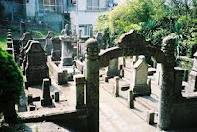 The 60th anniversary of the atomic blasts at Hiroshima and Nagasaki this month (August 2005) provides an occasion to recall the small but thriving Jewish community that once existed in the southern Japanese port city of Nagasaki.
The 60th anniversary of the atomic blasts at Hiroshima and Nagasaki this month (August 2005) provides an occasion to recall the small but thriving Jewish community that once existed in the southern Japanese port city of Nagasaki.
Nagasaki’s Jewish colony was founded by a few Jewish refugees fleeing the Russian pogroms of the 1880s; the town had long been frequented by Russia’s Far Eastern fleet. The community soon reached about 100 families in size. A synagogue, Beth Israel, was built in 1894.
With the outbreak of the Russo-Japanese War in 1904, the beleaguered Jewish community of Nagasaki passed its Torah scoll to its counterpart in Kobe. After a severe earthquake in 1923, the town’s remaining Jews relocated to Kobe for good. The Russian-born Zionist hero Joseph Trumpeldor (1880-1920), who lost an arm in the Russo-Japanese conflict, lived briefly in Nagasaki and was perhaps its most prominent congregant.
According to credible reports, no Jews were living in Nagasaki when it was devastated by the atomic explosion of August 9, 1945, three days after a similar atomic blast leveled Hiroshima.
Nineteen years later, in the summer of 1964, an American Jewish chaplain in Japan located an old map of Nagasaki that indicated the outline of an obscure rectangular enclosure on a local hilltop. A short taxi ride later, Chaplain Marvin Tokayer ended a trail had he had been pursuing for months.
Scattered in the field before him were numerous stone monuments, many engraved with Hebrew, Japanese, Russian and English characters, all dating between 1880 and 1920. The lost Jewish cemetery of Nagasaki had been found.
“The Jewish cemetery is on a hilltop overlooking a granite pillar marking the epicentre of the atomic blast,” reported The CJN in an unsigned article in August 1964. “The hill crest protected the cemetery from heat and blast, but almost 50 years of neglect had taken their toll and the grounds were sadly dilapidated.”
Tokayer enlisted some 20 Jews from the community of Tokyo, the Israeli Embassy and a local American marine corps station and airbase to “clean and restore the cemetery and to recite the Kel Moleh Rachamim . . . the prayers for the dead.
“With water buckets, weed removers, brushes and soap, everyone worked to clean moss from the grave stones and remove weeds from the grounds. It added purpose to the work to recall that a Jewish community lived, worked and worshipped near the very spot, Chaplain Tokayer asserted.”
We owe to Tokayer, who later became a noted expert on Oriental Jews and author of The Fugu Plan, the restoration of the old Jewish cemetery in the Sakamoto Gaijin district of Nagasaki. A photograph of the cemetery (shown here) and another of the synagogue appeared in the Jewish Encyclopedia, published in the United States between 1900 and 1906. ♦
© 2005






